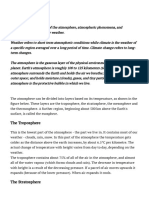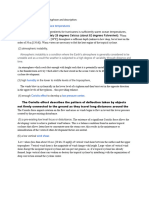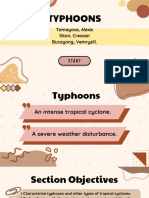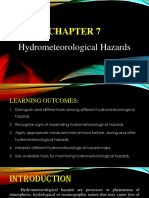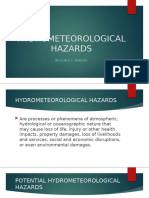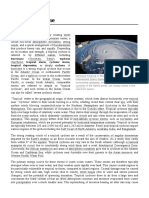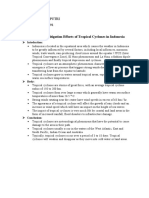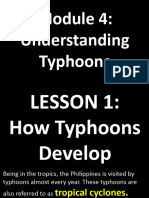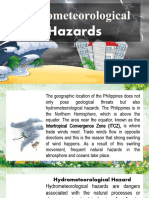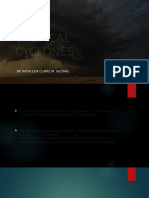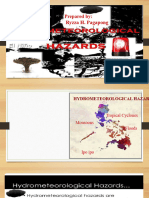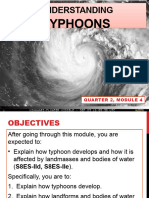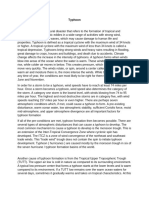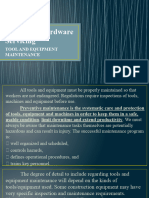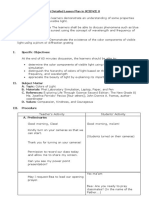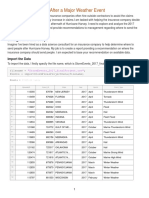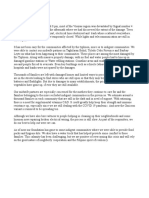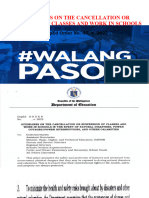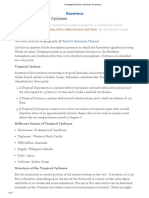0 ratings0% found this document useful (0 votes)
22 viewsQUARTER 2 LESSON 4 Understanding Typhoons
QUARTER 2 LESSON 4 Understanding Typhoons
Uploaded by
Jose BundalianTropical cyclones, known as typhoons in parts of Asia, form over warm ocean waters with sea surface temperatures greater than 26°C. They develop through the evaporation of ocean water and the convergence of air masses, resulting in the formation of intense low pressure systems with strong winds spiraling inward near the surface and outward at higher altitudes. The Philippines experiences around 19-20 typhoons per year due to its location near warm oceans that fuel typhoon formation and its landscape of islands and mountainous areas that can experience heavy rains and winds when typhoons make landfall.
Copyright:
© All Rights Reserved
Available Formats
Download as PDF, TXT or read online from Scribd
QUARTER 2 LESSON 4 Understanding Typhoons
QUARTER 2 LESSON 4 Understanding Typhoons
Uploaded by
Jose Bundalian0 ratings0% found this document useful (0 votes)
22 views18 pagesTropical cyclones, known as typhoons in parts of Asia, form over warm ocean waters with sea surface temperatures greater than 26°C. They develop through the evaporation of ocean water and the convergence of air masses, resulting in the formation of intense low pressure systems with strong winds spiraling inward near the surface and outward at higher altitudes. The Philippines experiences around 19-20 typhoons per year due to its location near warm oceans that fuel typhoon formation and its landscape of islands and mountainous areas that can experience heavy rains and winds when typhoons make landfall.
Copyright
© © All Rights Reserved
Available Formats
PDF, TXT or read online from Scribd
Share this document
Did you find this document useful?
Is this content inappropriate?
Tropical cyclones, known as typhoons in parts of Asia, form over warm ocean waters with sea surface temperatures greater than 26°C. They develop through the evaporation of ocean water and the convergence of air masses, resulting in the formation of intense low pressure systems with strong winds spiraling inward near the surface and outward at higher altitudes. The Philippines experiences around 19-20 typhoons per year due to its location near warm oceans that fuel typhoon formation and its landscape of islands and mountainous areas that can experience heavy rains and winds when typhoons make landfall.
Copyright:
© All Rights Reserved
Available Formats
Download as PDF, TXT or read online from Scribd
Download as pdf or txt
0 ratings0% found this document useful (0 votes)
22 views18 pagesQUARTER 2 LESSON 4 Understanding Typhoons
QUARTER 2 LESSON 4 Understanding Typhoons
Uploaded by
Jose BundalianTropical cyclones, known as typhoons in parts of Asia, form over warm ocean waters with sea surface temperatures greater than 26°C. They develop through the evaporation of ocean water and the convergence of air masses, resulting in the formation of intense low pressure systems with strong winds spiraling inward near the surface and outward at higher altitudes. The Philippines experiences around 19-20 typhoons per year due to its location near warm oceans that fuel typhoon formation and its landscape of islands and mountainous areas that can experience heavy rains and winds when typhoons make landfall.
Copyright:
© All Rights Reserved
Available Formats
Download as PDF, TXT or read online from Scribd
Download as pdf or txt
You are on page 1of 18
What is a typhoon?
Oceans and seas have great influences on the
weather of continental masses. A large portion of
the solar energy reaching the sea-surface is
expended in the process of evaporation. This water
evaporated from the sea/ocean is carried up into
the atmosphere and condenses, forming clouds from
which all forms of precipitation result. Sometimes,
intense cyclonic circulations occur which are what we
call tropical cyclones.
Tropical cyclones are warm-core low pressure systems
associated with a spiral inflow of mass at the bottom level
and spiral outflow at the top level. They always form over
oceans where sea surface temperature and air
temperatures are greater than 26°C. The air accumulates
large amounts of underlying heat as it spirals towards the
center. It receives this heat from the sea and the exchange
can occur rapidly, because of the large amount of spray
thrown into the air by the wind. The energy of the tropical
cyclone is thus derived from the massive liberation of the
underlying heat of condensation.
In other parts of the world, these are referred
to as hurricanes, typhoons or simply tropical cyclones
depending on the region. In the North Atlantic,
Eastern North Pacific and South Pacific Ocean, they
are called "hurricanes". In the Bay of Bengal,
Arabian Sea and Western South Indian Ocean, the
name is "cyclonic". In the eastern part of the
Southern Indian Ocean, it is
PARTS OF A TYPHOON
• EYE -The center. The calm part of the storm.
• EYE WALL – The Part around the eye. It has the
strongest winds and rains. Winds may blow
200 miles per hour.
• RAIN BANDS – These are clouds that spin.
Tropical depression, tropical storm, typhoon, and
supertyphoon are categories of a tropical cyclone. A
tropical cyclone is a system of thunderstorms which are
moving around a center. As the winds intensify or weaken,
the category is upgraded or downgraded accordingly.
How Landforms and Bodies
of Water Affect Typhoons
Tropical cyclones can only form over oceans of
the world except in the South Atlantic Ocean and the
South Eastern Pacific where a tropical cyclone could
never be formed due to the cooler sea surface
temperature and higher vertical wind shears. They
reach their greatest intensity while located over
warm tropical water. As soon as they move inland,
they begin to weaken, but often not before they
have caused great destruction.
The Philippines is prone to tropical cyclones due to
its geographical location which generally produce heavy
rains and flooding of large areas. It also susceptible to
strong winds which result in heavy casualties to human life
and destructions to crops and properties. Thus, it is of
utmost importance to have sufficient knowledge on such
maritime phenomena for beneficial purposes.
Philippines experienced many typhoons with
approximately 19-20 typhoons per year. And somewhat
each one of us is always fascinated with “WHY”.
Answer the following questions:
(For bodies of water)
1. What are the bodies of water that surround the
Philippines?
2. Explain why those bodies of water contributes to
the formation of typhoon.
3. Do you think it is safe to leave in an area near
the sea? Explain your answer.
(For Landmasses)
1. Based on the given map, give some examples of
landforms that form the Philippines?
2. What do you think will happened to a typhoon if
it hits the mountainous area of a particular place?
The formation of a typhoon involves the following
processes:
1. Evaporation of water at ocean surface temperatures of
26.5 degree Celsius
2. Convergence of air masses of different characteristics
3. High humidity
4. Warm air rises toward the cooler parts of the
atmosphere; it cools off and the water vapor begins to
form clouds
You might also like
- Aristo Interactive Geography 2nd Edition Book C2Document97 pagesAristo Interactive Geography 2nd Edition Book C2thomas011122100% (1)
- 05.HBRC 13 Feb - RedactedDocument58 pages05.HBRC 13 Feb - RedactedNewshubNo ratings yet
- Module 2Q SCI 8 2Document20 pagesModule 2Q SCI 8 2PeterClomaJr.No ratings yet
- LECTURE TyphoonDocument2 pagesLECTURE Typhoonlesleys472No ratings yet
- Typhoons 1Document18 pagesTyphoons 1Toga's LifeNo ratings yet
- 0 - DRR Research CreamsDocument5 pages0 - DRR Research CreamsGrace Javier-MejidanaNo ratings yet
- Understanding TyphoonsDocument53 pagesUnderstanding TyphoonsMikaela KayeNo ratings yet
- Module 2 4 - Lecture - Understanding TyphoonDocument25 pagesModule 2 4 - Lecture - Understanding Typhoonredox francisco100% (1)
- Assignment 2: 1. What Are The Four Alternative Terms Used For Tropical Cyclone?Document2 pagesAssignment 2: 1. What Are The Four Alternative Terms Used For Tropical Cyclone?Be the oneNo ratings yet
- Science8 q2 Mod4 Understanding TyphoonsDocument6 pagesScience8 q2 Mod4 Understanding TyphoonsArgyll Paguibitan0% (1)
- A A A Typhoon FormationDocument5 pagesA A A Typhoon FormationEva Mae ForcadillaNo ratings yet
- The Various Hazards That May Happen in The Wake of Tropical Cyclones, Monsoons, Floods or Ipo-IpoDocument20 pagesThe Various Hazards That May Happen in The Wake of Tropical Cyclones, Monsoons, Floods or Ipo-IpoPet Sensations100% (1)
- Synthesis PaperDocument11 pagesSynthesis PaperCesar Ian ManggolNo ratings yet
- Pingol, Jessica - LAS Q2 W6 Understanding TyphoonsDocument6 pagesPingol, Jessica - LAS Q2 W6 Understanding TyphoonsjhzcartNo ratings yet
- TyphoonsDocument12 pagesTyphoonsToga's LifeNo ratings yet
- LAS_UNDERSTANDING-TYPHOON_Q2-M4Document8 pagesLAS_UNDERSTANDING-TYPHOON_Q2-M4GenesisNo ratings yet
- Cyclones - Distribution and CausesDocument21 pagesCyclones - Distribution and CausesChaos InsurgencyNo ratings yet
- TyphoonsDocument45 pagesTyphoonsChristian James EdadesNo ratings yet
- Chapter 7 DRRRDocument37 pagesChapter 7 DRRRMark Angelo AlvarezNo ratings yet
- Science NotesDocument6 pagesScience Noteskyo- sanNo ratings yet
- Hydrometrological HazardsDocument23 pagesHydrometrological HazardsIril IanNo ratings yet
- 9 Hydrometeorological HazardsDocument17 pages9 Hydrometeorological HazardsElmer TamayaoNo ratings yet
- Quarter 2 Module 4 Understanding TyphoonDocument2 pagesQuarter 2 Module 4 Understanding Typhoonperrypetersonramos38No ratings yet
- Lecture 12DRRRDocument25 pagesLecture 12DRRRjohnzenurielalquisadaNo ratings yet
- Science TyphoonDocument3 pagesScience TyphoonNelson Budol100% (1)
- Tropical CycloneDocument55 pagesTropical CyclonePaul SimonNo ratings yet
- The Philippines Is Prone To Tropical CyclonesDocument4 pagesThe Philippines Is Prone To Tropical CyclonesfarhanieNo ratings yet
- TyphoonDocument18 pagesTyphoonJovelle HarinaNo ratings yet
- Hydrometeorological Hazards - Learning MaterialDocument5 pagesHydrometeorological Hazards - Learning MaterialRaven BerzabalNo ratings yet
- Week 6 Understanding Typhoons Part 1Document44 pagesWeek 6 Understanding Typhoons Part 1sksanbenitoNo ratings yet
- CycloneDocument8 pagesCyclonebiprasarker2No ratings yet
- Title: Impacts and Mitigation Efforts of Tropical Cyclones in IndonesiaDocument1 pageTitle: Impacts and Mitigation Efforts of Tropical Cyclones in IndonesiasitizahniaNo ratings yet
- 2 5 Tropical CyclonesDocument27 pages2 5 Tropical Cycloneszoafanai033No ratings yet
- Why Do Storms Have Names?Document7 pagesWhy Do Storms Have Names?ayeen miguelNo ratings yet
- John Alvin and The - Pokey GroupsDocument21 pagesJohn Alvin and The - Pokey GroupsPrecious SanianoNo ratings yet
- TC Information StudentsDocument10 pagesTC Information Studentsandysibbz100% (1)
- Module 2Document35 pagesModule 2GracielaNo ratings yet
- Q2 TyphoonDocument76 pagesQ2 TyphoonDaniel ManuelNo ratings yet
- Week 13 November 8-12, 2021 Activity TyphoonsDocument1 pageWeek 13 November 8-12, 2021 Activity TyphoonscordeliaNo ratings yet
- Q2-W4-TYPHOONv2Document70 pagesQ2-W4-TYPHOONv2Hannah Vi CarreonNo ratings yet
- Pacific Ocean: How Does Pacific Ocean Helps in Forming Typhoon?Document2 pagesPacific Ocean: How Does Pacific Ocean Helps in Forming Typhoon?Robbie William G. SañoNo ratings yet
- Meteorological HazardsDocument3 pagesMeteorological Hazardsjames_chong_16No ratings yet
- Research in DRRRMDocument19 pagesResearch in DRRRMEstelle BalbinNo ratings yet
- MODULE Soc Sci Ac1.5Document9 pagesMODULE Soc Sci Ac1.5Franklin BayaniNo ratings yet
- HydrometeorologicalDocument20 pagesHydrometeorologicalCloudy HeavenNo ratings yet
- Hydrometeorologicalhazards 191004133532Document103 pagesHydrometeorologicalhazards 191004133532yuhNo ratings yet
- Tropical CycloneDocument20 pagesTropical CycloneAngelica Dancalan ArenasNo ratings yet
- TYPHOONSDocument44 pagesTYPHOONSDaniella GalindezNo ratings yet
- Storm Surge-Thunderstorm-Tsunami-FloodsDocument5 pagesStorm Surge-Thunderstorm-Tsunami-FloodsHazel Anne TabilNo ratings yet
- TYPHOONDocument97 pagesTYPHOONarlenbalagotNo ratings yet
- 21 Tropical CyclonesDocument14 pages21 Tropical CyclonesLuisa LouisaNo ratings yet
- Hydrometeorological HazardDocument48 pagesHydrometeorological HazardMar ArizalaNo ratings yet
- L3 4th Quarter DRRR Hydrometeorological HazardsDocument41 pagesL3 4th Quarter DRRR Hydrometeorological HazardsApsimachiaNo ratings yet
- RyzzaDocument29 pagesRyzzadarrendumangasNo ratings yet
- Understanding TyphoonsDocument20 pagesUnderstanding Typhoonssherme.ordenezaNo ratings yet
- Emergency PlanDocument3 pagesEmergency Planjosephneilgatela43No ratings yet
- Weather DisturbancesDocument18 pagesWeather DisturbancesEunice Bawaan DomineNo ratings yet
- CyclonesDocument8 pagesCyclonesbaljitNo ratings yet
- Science 8 2023 2024 Module TyphoonDocument5 pagesScience 8 2023 2024 Module Typhoonalex.guirigay100% (1)
- Atlas of a Threatened Planet: 150 Infographics to Help Anyone Save the WorldFrom EverandAtlas of a Threatened Planet: 150 Infographics to Help Anyone Save the WorldNo ratings yet
- Tle 8 Household Services Lesson 7Document28 pagesTle 8 Household Services Lesson 7Jose BundalianNo ratings yet
- QUARTER 3 SCIENCE 8 LESSON 1 Properties of The Three States of MatterDocument27 pagesQUARTER 3 SCIENCE 8 LESSON 1 Properties of The Three States of MatterJose BundalianNo ratings yet
- Tool and Equipment MaintenanceDocument20 pagesTool and Equipment MaintenanceJose BundalianNo ratings yet
- QUARTER 2 LESSON 3 How Seismic Waves Provide Information About The Information of The EarthDocument21 pagesQUARTER 2 LESSON 3 How Seismic Waves Provide Information About The Information of The EarthJose BundalianNo ratings yet
- QUARTER 2 LESSON 5 Pathway of TyphoonDocument17 pagesQUARTER 2 LESSON 5 Pathway of TyphoonJose BundalianNo ratings yet
- K - To - 12 - Electrical - Learning - Module v1Document178 pagesK - To - 12 - Electrical - Learning - Module v1Jose Bundalian100% (1)
- Tle 6 AgricultureDocument3 pagesTle 6 AgricultureJose BundalianNo ratings yet
- Tle 6 Industrial ArtsDocument2 pagesTle 6 Industrial ArtsJose BundalianNo ratings yet
- I Am Sharing 'Colors of Light' With YouDocument12 pagesI Am Sharing 'Colors of Light' With YouJose BundalianNo ratings yet
- Unit 3 - DangerDocument6 pagesUnit 3 - DangerMayte BarrigaNo ratings yet
- Peer AssessmentDocument47 pagesPeer AssessmentUmair Ejaz ButtNo ratings yet
- Wetlands: Disaster PreparednessDocument16 pagesWetlands: Disaster PreparednessMikela DelatoreNo ratings yet
- Contingency Plan For LandslideDocument19 pagesContingency Plan For LandslideMilagrosBautistaNo ratings yet
- WK 5 WIND Beaufort ScaleDocument11 pagesWK 5 WIND Beaufort Scalekimcristobal52No ratings yet
- Natural Disasters Phrasal Verbs and Idioms Conversation Topics Dialogs Reading Comprehension 100729Document4 pagesNatural Disasters Phrasal Verbs and Idioms Conversation Topics Dialogs Reading Comprehension 100729Stefania PopaNo ratings yet
- The Weather TVDocument8 pagesThe Weather TVVictor SNo ratings yet
- BILAOS Infographics DRRR Week-3Document1 pageBILAOS Infographics DRRR Week-3macjhoven bilaosNo ratings yet
- PresentationDocument3 pagesPresentationElizamae Con-oNo ratings yet
- Windfinder - Wind & Weather Forecast Galveston South BuoyDocument5 pagesWindfinder - Wind & Weather Forecast Galveston South BuoySwapnil KhandkeNo ratings yet
- Public Storm Warning SignalDocument3 pagesPublic Storm Warning Signalpitong_manning100% (3)
- 1 s2.0 S2225603221000278 MainDocument10 pages1 s2.0 S2225603221000278 Maincincomariel090902No ratings yet
- Tropical Cyclones-1Document15 pagesTropical Cyclones-1SaimanNo ratings yet
- Typhoon Rai OdetteDocument1 pageTyphoon Rai OdetteJeremy DamazoNo ratings yet
- Typhoons Year 2004 2024 ArticlesDocument18 pagesTyphoons Year 2004 2024 ArticlesrynamatipoNo ratings yet
- Statement of Overtime Services RenderedDocument3 pagesStatement of Overtime Services RenderedSeventh HokageNo ratings yet
- Tropical Storm Trami (2024) - WikipediaDocument1 pageTropical Storm Trami (2024) - WikipediaNitsan MugurNo ratings yet
- Orca Share Media1667550660664 6994214406226372756Document5 pagesOrca Share Media1667550660664 6994214406226372756Cyrus DestajoNo ratings yet
- What Are Hydrometeorological Hazards?Document6 pagesWhat Are Hydrometeorological Hazards?deymgoodsNo ratings yet
- Strap Beam Plan (STB) Reinforcement Details of Strap Beam (SB) of Section A-ADocument1 pageStrap Beam Plan (STB) Reinforcement Details of Strap Beam (SB) of Section A-AlukeNo ratings yet
- Campbell 10Document2 pagesCampbell 10Dora RibesNo ratings yet
- PARDocument32 pagesPARVeth QuimNo ratings yet
- DSWD DROMIC Report 70 On Severe Tropical Storm Paeng As of 06 JanuaryDocument99 pagesDSWD DROMIC Report 70 On Severe Tropical Storm Paeng As of 06 JanuaryCPDO PMCNo ratings yet
- ĐỀ 4Document5 pagesĐỀ 4nguyenchau2511No ratings yet
- Hunting For Landslides in ST Lucia... by Catherine PenningtonDocument13 pagesHunting For Landslides in ST Lucia... by Catherine PenningtonッGod is GoodNo ratings yet
- Class SuspensionDocument17 pagesClass SuspensionBensonjr Magaway De OcampoNo ratings yet
- Warning-18 (ORANGE) : Impact Based Heavy Rainfall Warning For DISTRICTS OF TELANGANA/ Hyderabad City 03-HourlyDocument4 pagesWarning-18 (ORANGE) : Impact Based Heavy Rainfall Warning For DISTRICTS OF TELANGANA/ Hyderabad City 03-HourlyMoran RajNo ratings yet
- Competitive Exams: Cyclones: ExamraceDocument2 pagesCompetitive Exams: Cyclones: ExamraceAamir KhanNo ratings yet




